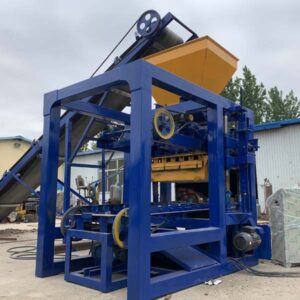
In the realm of modern construction, concrete block machines have emerged as integral tools that bridge the gap between raw materials and functional building blocks.
These machines play a crucial role in transforming raw aggregates and cementitious materials into the sturdy and versatile building components that form the backbone of our built environment.
This essay delves into the intricate processes that occur within concrete block machines, shedding light on their inner workings and their significance in the construction industry.
Material Preparation: The Foundation of Block Production
At the heart of every concrete block lies a precise blend of raw materials that determines its strength, durability, and overall performance.
The process begins with the selection and preparation of aggregates, which include sand, gravel, crushed stone, and sometimes recycled materials.
These aggregates are meticulously screened and cleaned to remove impurities that could compromise the quality of the final blocks.
Cement, another vital ingredient, binds the aggregates together. Modern concrete block machines utilize various types of cement, each with specific properties suited for different applications.
The right proportion of cement to aggregates is crucial to achieving the desired strength and consistency.
Advanced machines use computerized systems to ensure accurate measurements, reducing human error and material wastage.
Mixing and Blending: Achieving Homogeneity
Once the aggregates and cement are prepared, they are introduced into the concrete block machine’s mixing chamber.
Here, the materials undergo a thorough blending process to achieve homogeneity.
The efficiency of this mixing stage directly influences the quality and uniformity of the blocks produced.
Contemporary concrete block machines employ both batch mixers and continuous mixers.
Batch mixers combine predetermined quantities of aggregates and cement, creating a homogeneous mixture in discrete batches.
Continuous mixers, on the other hand, continuously feed and blend the materials, ensuring a consistent mixture throughout the production process.
Whichever method is used, the goal is to create a well-distributed blend that maximizes the material’s binding capabilities and structural integrity.
Molding and Compression: Shaping the Future Blocks
With a properly blended mixture in hand, the next stage involves shaping the raw material into the desired block form.
Molding is a critical step that impacts the final aesthetics, dimensions, and strength of the blocks.
Traditional concrete block machines employed static molds, which required manual handling and demolding of the blocks.
However, recent advancements have introduced automated molding systems that significantly enhance efficiency and precision.
Advanced concrete block machines utilize hydraulic or pneumatic pressure to compress the material within the mold.
This compression not only imparts the desired shape to the block but also removes excess air voids, ensuring a denser and more durable end product.
The automated nature of these machines ensures that each block is uniformly compressed, leading to consistent quality throughout the production process.
Curing and Quality Control: Building Block Resilience
After the blocks are molded, they undergo a curing process to develop their strength and durability.
Curing involves maintaining optimal temperature and moisture conditions to encourage the chemical reactions within the cementitious material, resulting in the formation of strong bonds.
This stage is crucial for the long-term performance of the blocks, as inadequate curing can lead to reduced strength and increased susceptibility to cracking.
Advanced concrete block machines often incorporate curing chambers that provide controlled environments for the blocks to cure.
Automated systems monitor and regulate temperature and moisture levels, ensuring uniform curing across all blocks.
Additionally, quality control mechanisms, such as regular testing for compressive strength and dimensional accuracy, are integrated into these machines to identify any deviations from the desired standards.
Concrete block machines serve as the backbone of modern construction by transforming raw materials into the essential building blocks that shape our cities and communities.
The intricate processes within these machines, from material preparation to curing and quality control, highlight their significance in ensuring the structural integrity, aesthetics, and functionality of buildings.
As technology continues to advance, the inner workings of concrete block machines are poised to become even more sophisticated, leading to more efficient, sustainable, and innovative construction practices. From raw material to finished block, these machines embody the essence of transformation in the construction industry.
